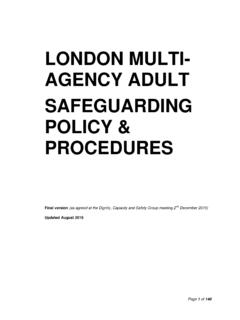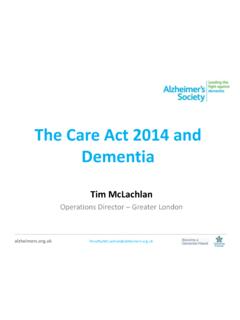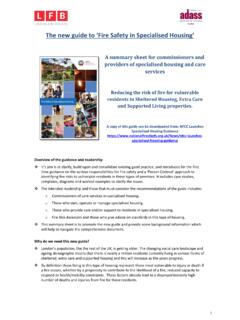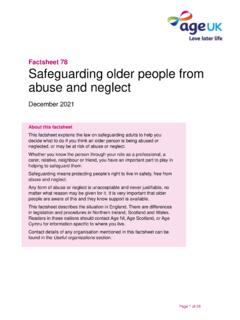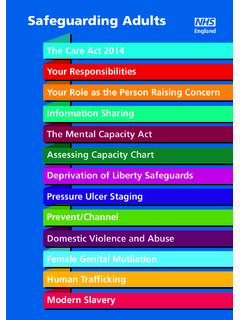Transcription of LONDON MULTI- AGENCY ADULT SAFEGUARDING POLICY …
1 Page 1 of 160 LONDON MULTI- AGENCY ADULT SAFEGUARDING POLICY & PROCEDURES Final version (as agreed by the LONDON SAFEGUARDING ADULT Board)) April 2019 Page 2 of 160 Foreword The introduction of the Care Act 2014 put ADULT SAFEGUARDING on a statutory footing for the first time, embracing the principle that the person knows best . It laid the foundation for change in the way that care and support is provided to adults, encouraging greater self -determination, so people maintain independence and have real choice. There is an emphasis on working with adults at risk of abuse and neglect to have greater control in their lives to both prevent it from happening, and to give meaningful options of dealing with it should it occur. For staff the Care Act provides clearer guidance, and supports pathways to working in an integrated way, breaking down barriers between organisations.
2 This approach has been championed by all the organisations who have worked together to produce this new POLICY and procedures which replaces ( LONDON multi- AGENCY POLICY and procedures, 2015). The increased involvement of adults who use services, carers, statutory and non-statutory groups in the production of this document embraces the spirit of the Act and the vision for SAFEGUARDING to be everyone s business. The POLICY and procedures have benefitted from carers and adults who might be at risk, to provide a reality check on what is meaningful and makes sense. This approach is a core element of a personalised ADULT SAFEGUARDING service. Since the earlier POLICY and procedures, progress has been made to improve practice, through learnt experience, feedback and translating POLICY and procedures so that there is a shared approach to ADULT SAFEGUARDING .
3 This POLICY and procedures take us further towards putting the adults at the centre of their own SAFEGUARDING experience. By developing practice that listens and learns, staff working with the person at risk can share information, facilitating a one team approach to improve the chances of SAFEGUARDING adults in the way that they want to be safeguarded. Learning from the experiences of people, publicised SAFEGUARDING annual reports, and events to raise greater awareness has enabled staff and SAB partnerships to reflect on SAFEGUARDING practice. All organisations involved have been consulted and worked collaboratively to update this POLICY and procedures. They are therefore, for all organisations and all those working in them, whether they hold a strategic leadership role or work directly with adults.
4 This POLICY and procedures consolidate our experience to date. It aims to encourage the continuous development of best practice in order to better safeguard adults throughout LONDON . We welcome the advances we have made in ADULT SAFEGUARDING and the collegiate approach that this revised edition has taken. Dawn Wakeling Executive Director, Adults and Health, LONDON Borough of Barnet and Chair of the LONDON SAFEGUARDING ADULT Board Page 3 of 160 Acknowledgements The LONDON SAFEGUARDING ADULT Board would like to thank all the individuals, statutory and non-statutory representatives and agencies that contributed their expertise and time to make this document possible. The review was led by the Editorial Board (Chaired by Derek Oliver) and supported by consultation with the SAFEGUARDING professionals steering group.
5 The update was ably supported by Tristan Brice and the LondonADASS team. Special thanks to Matt Hutchings (Cornerstone Barristers) for reviewing the document through a legal lens. Finally, our thanks to: Care Quality Commission Circle Housing Chief Coroner s Office Department of Health Healthwatch England Housing and SAFEGUARDING Adults Alliance LONDON Ambulance Service LONDON Borough of Sutton Housing Service LONDON Community Rehabilitation Company Local Government Association LONDON Fire Brigade National Probation Service LONDON LONDON Provider Alliance LONDON SAFEGUARDING Adults Network LONDON Social Care Partnership Networks: o Assistant Directors o Carers Leads o Commissioners o Learning Disability o SAB Chairs Metropolitan Police Service NHS England ( LONDON ) CCG SAFEGUARDING Forum NHS England NHS Provider SAFEGUARDING Forum Social Care Institute for Excellence Skills for Care West Midlands SAFEGUARDING Adults Board Women s Aid Page 4 of 160 Glossary and Acronyms In using this document, a number of phrases, wording or acronyms have been used.
6 The following provides more information and, where necessary, a definition: ADULT at risk is a person aged 18 or over who is in need of care and support (whether or not those needs are being met), who is experiencing or at risk of abuse or neglect, and because of those needs is unable to protect themselves against the abuse or neglect or the risk of it. ADULT SAFEGUARDING means protecting a person s right to live in safety, free from abuse and neglect. ADULT SAFEGUARDING lead is the title given to the member of staff in an organisation who is given the lead for SAFEGUARDING Adults. Advocacy is supporting a person to understand information, express their needs and wishes, secure their rights, represent their interests and obtain the care and support they need. Appropriate ADULT is a specific role prescribed under the Police & Criminal Evidence Act 1984.
7 The role of an appropriate ADULT is confined to instances where a police officer has any suspicion, or is told in good faith, that a person of any age may be mentally disordered or otherwise mentally vulnerable, in the absence of clear evidence to dispel that suspicion, the person shall be treated as a vulnerable ADULT and supported by an Appropriate ADULT . Appropriate individual within this document an appropriate individual is a person who supports an ADULT at risk typically but not exclusively in an advocacy role and is separate to an Appropriate ADULT as described above. Borough Operational Command Unit (BOCU) the regional units of the Metropolitan Police based on the 32 LONDON Boroughs. Best Interest - the Mental Capacity Act 2005 (MCA) states that if a person lacks mental capacity to make a particular decision then whoever is making that decision or taking any action on that person s behalf must do so in the person s best interest.
8 This is one of the principles of the MCA. Care setting is where a person receives care and support from health and social care organisations. This includes hospitals, hospices, respite units, nursing homes, residential care homes, and day opportunities arrangements. Carer throughout these POLICY and procedures refers to a Family/Friend Carer as distinct from a paid carer, who is referred to throughout as Support Worker. The Association of Directors of ADULT Social Services (ADASS) define a carer as someone who spends a significant proportion of their time providing unpaid support to a family member, partner or friend who is ill, frail, disabled or has mental health or substance misuse problems . Commissioning is the cyclical activity, to assess the needs of local populations for care and support services, determining what element of this, needs to be arranged by the respective organisations, then designing, delivering, monitoring and evaluating those services.
9 Community Safety Units (CSUs) operate in every area in LONDON with dedicated staff who receive special training in community relations, including local cultural issues. The CSUs will investigate the following incidents: domestic violence, homophobia, transphobia and racism, criminal offences where a person has been targeted because of their perceived race , faith, sexual orientation or disability. Page 5 of 160 Concern is the term used to describe when there is or might be an incident of abuse or neglect and it replaces the previously use term of alert . Contracting is the means by which a process is made legally binding. Contract management is the process that then ensures that services continue to be delivered to the agreed quality standards. Disclosure and Barring Service (DBS) helps employers make safer recruitment decisions and prevent unsuitable people from working with vulnerable groups.
10 It replaces the Criminal Records Bureau (CRB) and Independent SAFEGUARDING Authority (ISA). Enquiry establishes whether any action needs to be taken to stop or prevent abuse or neglect, and if so, what action and by whom the action is taken. Previously this may have been referred to as a referral Enquiry Lead is the AGENCY who leads the enquiry described above. Enquiry Officer is the member of staff who undertakes and co-ordinates the actions under Section 42 (Care Act 2014) enquiries. Equality Act 2010 legally protects people from discrimination in the workplace and in wider society. It replaced previous anti-discrimination laws with a single Act, making the law easier to understand and strengthening protection in some situations. It sets out the different ways in which it is unlawful to treat someone.
